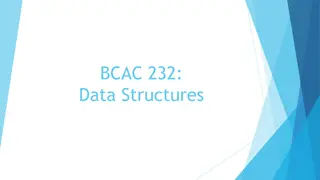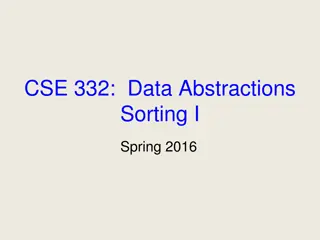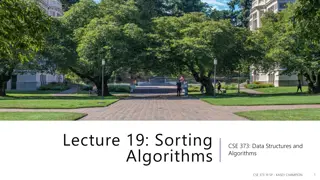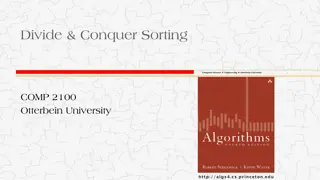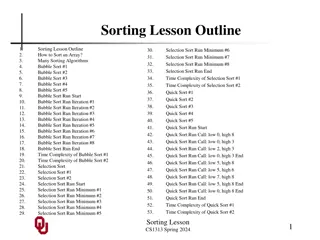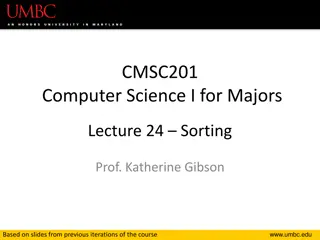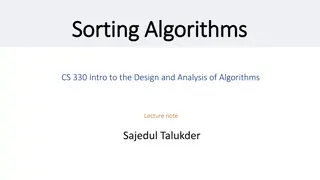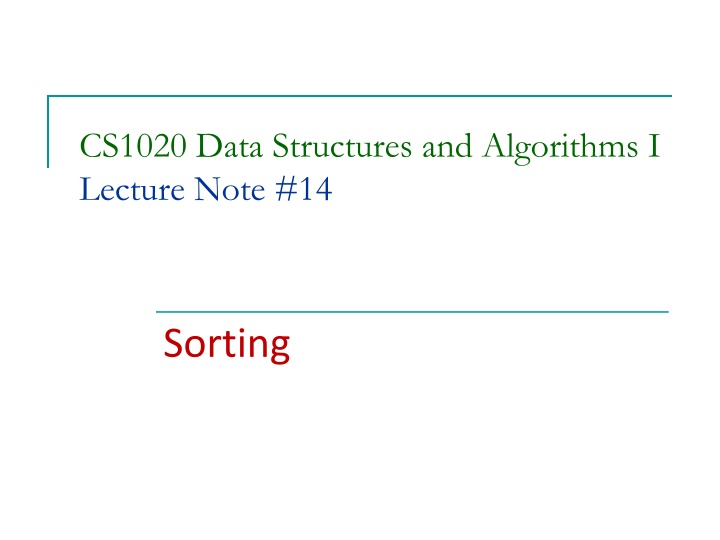
Sorting Algorithms in Data Structures and Algorithms
Learn about classic sorting algorithms, analyze their performance, explore in-place and stable sorts, and use Java methods for sorting. Discover the importance of sorting in problem-solving and various sorting applications.
Download Presentation

Please find below an Image/Link to download the presentation.
The content on the website is provided AS IS for your information and personal use only. It may not be sold, licensed, or shared on other websites without obtaining consent from the author. If you encounter any issues during the download, it is possible that the publisher has removed the file from their server.
You are allowed to download the files provided on this website for personal or commercial use, subject to the condition that they are used lawfully. All files are the property of their respective owners.
The content on the website is provided AS IS for your information and personal use only. It may not be sold, licensed, or shared on other websites without obtaining consent from the author.
E N D
Presentation Transcript
CS1020 Data Structures and Algorithms I Lecture Note #14 Sorting
Objectives To learn some classic sorting algorithms 1 To analyse the running time of these algorithms 2 To learn concepts such as in-place sorts and stable sorts 3 Using Java methods to perform sorting 4 [CS1020 Lecture 14: Sorting] 2
References Book Chapter 10: Algorithm Efficiency and Sorting, pages 542 to 577. CS1020 website Resources Lectures http://www.comp.nus.edu.sg/ ~cs1020/2_resources/lectures.html [CS1020 Lecture 14: Sorting] 3
Programs used in this lecture SelectionSort.java BubbleSort.java, BubbleSortImproved.java InsertionSort.java MergeSort.java QuickSort.java Sort.java, Sort2.java Person.java, AgeComparator.java, NameComparator.java, TestComparator.java [CS1020 Lecture 14: Sorting] 4
Why Study Sorting? When an input is sorted by some sort key, many problems become easy (eg. searching, min, max, kth smallest, etc.) Q: What is a sort key? Sorting has a variety of interesting algorithmic solutions, which embody many ideas: Internal sort vs external sort Iterative vs recursive Comparison vs non-comparison based Divide-and-conquer Best/worst/average case bounds [CS1020 Lecture 14: Sorting] 5
Sorting applications Uniqueness testing Deleting duplicates Frequency counting Set intersection/union/difference Efficient searching Dictionary Telephone/street directory Index of book Author index of conference proceedings etc. [CS1020 Lecture 14: Sorting] 6
Outline Comparison based and Iterative algorithms Selection Sort Bubble Sort Insertion Sort Comparison based and Recursive algorithms Merge Sort Quick Sort Non-comparison based Radix Sort 1. 2. 3. 4. 5. 6. 7. Comparison of Sort Algorithms In-place sort Stable sort 8. Use of Java Sort Methods Note: We consider only sorting in ascending order of data. [CS1020 Lecture 14: Sorting] 7
1 Idea of Selection Sort Given an array of n items 1. Find the largest item. 2. Swap it with the item at the end of the array. 3. Go to step 1 by excluding the largest item from the array. [CS1020 Lecture 14: Sorting] 9
1 Selection Sort of 5 integers 37 is the largest, swap it with the last element, i.e. 13. Q: How to find the largest? 29 10 14 37 13 29 10 14 13 37 13 10 14 29 37 13 10 14 29 37 10 13 14 29 37 Sorted! [CS1020 Lecture 14: Sorting] 10
1 Code of Selection Sort public static public static void for (int i = a.length-1; i >= 1; i--) { int index = i; // i is the last item position and // index is the largest element position // loop to get the largest element for (int j = 0; j < i; j++) { if (a[j] > a[index]) index = j; // j is the current largest item } // Swap the largest item a[index] with the last item a[i] int temp = a[index]; a[index] = a[i]; a[i] = temp; } } void selectionSort selectionSort(int[] (int[] a) a) { SelectionSort.java [CS1020 Lecture 14: Sorting] 11
1 Analysis of Selection Sort public static void public static void selectionSort { selectionSort(int[] a) (int[] a) Number of times the statement is executed: n-1 for for (int i=a.length-1; i>=1; i--) { int index = i; for for (int j=0; j<i; j++) { if (a[j] > a[index]) index = j; } } SWAP( ... ) } } } n-1 (n-1)+(n-2)+ +1 = n (n-1)/2 n-1 Total = t1 (n-1) + t2 n (n-1)/2 = O(n2) t1 and t2 = costs of statements in outer and inner blocks. [CS1020 Lecture 14: Sorting] 12
2 Idea of Bubble Sort Bubble down the largest item to the end of the array in each iteration by examining the i-th and (i+1)-th items If their values are not in the correct order, i.e. a[i] > a[i+1], swap them. 1 4 6 9 1 7 5 9 i i+1 i i+1 // no need to swap // not in order, need to swap [CS1020 Lecture 14: Sorting] 14
2 Example of Bubble Sort The first two passes of Bubble Sort for an array of 5 integers At the end of pass 2, the second largest item 29 is at the second last position. At the end of pass 1, the largest item 37 is at the last position. [CS1020 Lecture 14: Sorting] 15
2 Code of Bubble Sort public static void public static void bubbleSort for (int i = 1; i < a.length; i++) { for (int j = 0; j < a.length - i; j++) { if (a[j] > a[j+1]) { // the larger item bubbles down (swap) int temp = a[j]; a[j] = a[j+1]; a[j+1] = temp; } } } } bubbleSort(int[] a) (int[] a) { BubbleSort.java Bubble Sort animation [CS1020 Lecture 14: Sorting] 16
2 Analysis of Bubble Sort 1 iteration of the inner loop (test and swap) requires time bounded by a constant c Doubly nested loops: public static void bubbleSort(int[ ] a) { for (int i = 1; i < a.length; i++) { for (int j = 0; j < a.length - i; j++) { if (a[j] > a[j+1]) { // (swap) int temp = a[j]; a[j] = a[j+1]; a[j+1] = temp; } } } } Outer loop: exactly n-1 iterations Inner loop: When i=1, (n-1) iterations When i=2, (n-2) iterations When i=(n-1), 1 iteration Total number of iterations = (n-1) + (n-2) + + 1 = n (n-1)/2 Total time = c n (n-1)/2 = O(n2) [CS1020 Lecture 14: Sorting] 17
2 Bubble Sort is inefficient Given a sorted input, Bubble Sort still requires O(n2) to sort. It does not make an effort to check whether the input has been sorted. Thus it can be improved by using a flag, isSorted, as follows (next slide): [CS1020 Lecture 14: Sorting] 18
2 Code of Bubble Sort (Improved version) public static void public static void bubbleSort2(int[] a) { bubbleSort2(int[] a) { for (int i = 1; i < a.length; i++) { boolean isSorted = true; // isSorted = true if a[] is sorted for (int j = 0; j < a.length-i; j++) { if (a[j] > a[j+1]) { // the larger item bubbles up int temp = a[j]; // and isSorted is set to false, a[j] = a[j+1]; // i.e. the data was not sorted a[j+1] = temp; isSorted = false; } } if (isSorted) return; // Why? } } BubbleSortImproved.java [CS1020 Lecture 14: Sorting] 19
2 Analysis of Bubble Sort(Improved version) Worst case Input in descending order How many iterations in the outer loop are needed? Answer: n-1 iterations Running time remains the same: O(n2) Best case Input is already in ascending order The algorithm returns after a single iteration in the outer loop. (Why?) Running time: O(n) [CS1020 Lecture 14: Sorting] 20
3 Idea of Insertion Sort Arranging a hand of poker cards Start with one card in your hand Pick the next card and insert it into its proper sorted order Repeat previous step for all the rest of the cards [CS1020 Lecture 14: Sorting] 22
3 Example of Insertion Sort n = 4 S1 Given a seq: 40 13 20 8 i=1 13 40 20 8 i=2 13 20 40 8 i=3 8 13 20 40 S2 n = no of items to be sorted S1 = sub-array sorted so far S2 = elements yet to be processed In each iteration, how to insert the next element into S1 efficiently? [CS1020 Lecture 14: Sorting] 23
3 Code of Insertion Sort public static void public static void insertionSort(int[] a) insertionSort(int[] a) { for (int i=1;i<a.length;i++) { //Q: Why i starts from 1? // a[i] is the next data to insert int next = a[i]; // Scan backwards to find a place. Q: Why not scan forwards? int j; // Q: Why is j declared here? // Q: What if a[j] <= next? for (j=i-1; j>=0 && a[j]>next; j--) a[j+1] = a[j]; // Now insert the value next after index j at the end of loop a[j+1] = next; } } InsertionSort.java Q: Can we replace these two next with a[i]? [CS1020 Lecture 14: Sorting] 24
3 Analysis of Insertion Sort Outer loop executes exactly n-1 times Number of times inner loop executes depends on the inputs: Best case: array already sorted, hence (a[j] > next) is always false No shifting of data is necessary; Inner loop not executed at all. Worst case: array reversely sorted, hence (a[j] > next) is always true Need i shifts for i = 1 to n-1. Insertion always occurs at the front. Therefore, the best case running time is O(n). (Why?) The worst case running time is O(n2). (Why?) ... ... insertionSort(int[] a) insertionSort(int[] a) { for (int i=1;i<a.length;i++) { int next = a[i]; int j; for (j=i-1; j>=0 && a[j]>next; j--) a[j+1] = a[j]; a[j+1] = next; } } [CS1020 Lecture 14: Sorting] 25
4 Idea of Merge Sort (1/3) Suppose we only know how to merge two sorted lists of elements into one combined list Given an unsorted list of n elements Since each element is a sorted list, we can repeatedly Merge each pair of lists, each list containing one element, into a sorted list of 2 elements. Merge each pair of sorted lists of 2 elements into a sorted list of 4 elements. The final step merges 2 sorted lists of n/2 elements to obtain a sorted list of n elements. [CS1020 Lecture 14: Sorting] 27
4 Idea of Merge Sort (2/3) Divide-and-conquer method solves problem by three steps: Divide Step: divide the larger problem into smaller problems. (Recursively) solve the smaller problems. Conquer Step: combine the results of the smaller problems to produce the result of the larger problem. [CS1020 Lecture 14: Sorting] 28
4 Idea of Merge Sort (3/3) Merge Sort is a divide-and-conquer sorting algorithm Divide Step: Divide the array into two (equal) halves. (Recursively) sort the two halves. Conquer Step: Merge the two sorted halves to form a sorted array. Q: What are the base cases? [CS1020 Lecture 14: Sorting] 29
4 Example of Merge Sort 7 2 6 3 8 4 5 Divide into two halves 7 2 6 3 8 4 5 Recursively sort the halves 2 3 6 7 4 5 8 2 3 4 5 6 7 8 Mergethe halves [CS1020 Lecture 14: Sorting] 30
4 Code of Merge Sort ... ... mergeSort(int[] a, int i, int j) mergeSort(int[] a, int i, int j) { // to sort data from a[i] to a[j], where // to sort data from a[i] to a[j], where i i<j if (i < j) { // Q: Q: What if i >= j? int mid = (i+j)/2; // divide mergeSort(a, i, mid); // recursion mergeSort(a, mid+1, j); merge(a,i,mid,j); //conquer: merge a[i..mid] and //a[mid+1..j] back into a[i..j] } } <j MergeSort.java [CS1020 Lecture 14: Sorting] 31
4 Merge Sort of a 6-element Array (1/2) mergeSort(a,i,mid); mergeSort(a,mid+1,j); merge(a,i,mid,j); 38 16 27 39 12 27 39 12 27 38 16 27 27 38 16 27 39 12 38 16 39 12 16 38 12 39 16 27 38 12 27 39 12 16 27 27 38 39 [CS1020 Lecture 14: Sorting] 32
4 Merge Sort of a 6-element Array (2/2) mergeSort(a,i,mid); mergeSort(a,mid+1,j); merge(a,i,mid,j); 38 16 27 39 12 27 39 12 27 38 16 27 Divide phase: Recursive call to mergeSort 27 38 16 27 39 12 38 16 39 12 16 38 12 39 Conquer phase: Merge steps The sorting is done here 16 27 38 12 27 39 12 16 27 27 38 39 [CS1020 Lecture 14: Sorting] 33
4 How to Merge 2 Sorted Subarrays? Temp array t[0..5] a[0..2] a[3..5] 2 4 5 3 7 8 2 2 4 5 3 7 8 2 3 2 4 5 3 7 8 2 3 4 2 4 5 3 7 8 2 3 4 5 2 4 5 3 7 8 2 3 4 5 7 8 2 4 5 3 7 8 [CS1020 Lecture 14: Sorting] 34
4 Merge Algorithm (1/2) ... ... merge(int[] a, int i, int mid, int j) merge(int[] a, int i, int mid, int j) { // Merges the 2 sorted sub-arrays a[i..mid] and // a[mid+1..j] into one sorted sub-array a[i..j] int[] temp = new int[j-i+1]; // temp storage int left = i, right = mid+1, it = 0; // it = next index to store merged item in temp[] // Q: Q: What are left and right? while (left<=mid && right<=j) { // output the smaller if (a[left] <= a[right]) temp[it++] = a[left++]; else temp[it++] = a[right++]; } [CS1020 Lecture 14: Sorting] 35
4 Merge Algorithm (2/2) // Copy the remaining elements into temp. Q: Why? while (left<=mid) temp[it++] = a[left++]; while (right<=j) temp[it++] = a[right++]; // Q: Will both the above while statements be executed? // Copy the result in temp back into // the original array a for (int k = 0; k < temp.length; k++) a[i+k] = temp[k]; } [CS1020 Lecture 14: Sorting] 36
4 Analysis of Merge Sort (1/3) In Merge Sort, the bulk of work is done in the Merge step merge(a, i, mid, j) Total number of items = k = j i + 1 Number of comparisons k 1 (Q: Why not = k 1?) Number of moves from original array to temp array = k Number of moves from temp array to original array = k In total, number of operations 3k 1 = O(k) How many times is merge() called? ... ... mergeSort(int[] a, int i, int j) mergeSort(int[] a, int i, int j) { if (i < j) { int mid = (i+j)/2; mergeSort(a, i, mid); mergeSort(a, mid+1, j); merge(a,i,mid,j); } } [CS1020 Lecture 14: Sorting] 37
4 Analysis of Merge Sort (2/3) Level 0: Mergesort n items Level 0: 0 call to Merge n Level 1: 2 calls to Mergesort n/2 items Level 1: 1 calls to Merge n/2 n/2 Level 2: 4 calls to Mergesort n/22 items Level 2: 2 calls to Merge n/22 n/22 n/22 n/22 Level (log n): 2(log n) -1(= n/2) calls to Merge Level (log n): n calls to Mergesort 1 item 1 1 1 1 Let k be the maximum level, ie. Mergesort 1 item. n/(2k ) = 1 n = 2k k = log n [CS1020 Lecture 14: Sorting] 38
4 Analysis of Merge Sort (3/3) Level 0: 0 call to Merge Level 1: 1 call to Merge with n/2 items each, O(1 2 n/2) = O(n) time Level 2: 2 calls to Merge with n/22 items each, O(2 2 n/22) = O(n) time Level 3: 22 calls to Merge with n/23 items each, O(22 2 n/23) = O(n) time Level (log n): 2(log n)-1(= n/2) calls to Merge with n/2log n (= 1) item each, O(n/2 2 x 1) = O(n) time In total, running time = (log n)*O(n) = O(n log n) [CS1020 Lecture 14: Sorting] 39
4 Drawbacks of Merge Sort Implementation of merge() is not straightforward Requires additional temporary arrays and to copy the merged sets stored in the temporary arrays to the original array Hence, additional space complexity = O(n) [CS1020 Lecture 14: Sorting] 40
5 Idea of Quick Sort Quick Sort is a divide-and-conquer algorithm Divide Step: Choose a pivot item p and partition the items of a[i..j] into 2 parts so that Items in the first part are < p, and Items in the second part are p. Recursively sort the 2 parts Conquer Step: Do nothing! No merging is needed. What are the base cases? Note: Merge Sort spends most of the time in conquer step but very little time in divide step. Q: How about Quick Sort? Q: Is it similar to the Recursion lecture notes on finding the Kth smallest element? [CS1020 Lecture 14: Sorting] 42
5 Example of Quick Sort Pivot 27 38 12 39 27 16 Pivot Choose the 1st item as pivot Partition a[] about the pivot 27 16 12 27 39 27 38 Pivot Recursively sort the two parts 12 16 27 27 38 39 Note that after the partition, the pivot is moved to its final position! No merge phase is needed. [CS1020 Lecture 14: Sorting] 43
5 Code of Quick Sort ... ... quickSort(int[] a, int i, int j) quickSort(int[] a, int i, int j) { if (i < j) { // Q: Q: What if i >= j? int pivotIdx = partition(a, i, j); quickSort(a, i, pivotIdx-1); quickSort(a, pivotIdx+1, j); // No conquer part! Why? } } QuickSort.java [CS1020 Lecture 14: Sorting] 44
5 Partition algorithm idea (1/4) To partition a[i..j], we choose a[i] as the pivot p. Why choose a[i]? Are there other choices? The remaining items (i.e. a[i+1..j]) are divided into 3 regions: S1 = a[i+1..m] where items < p S2 = a[m+1..k-1] where item p Unknown (unprocessed) = a[k..j], where items are yet to be assigned to S1 or S2. p p i < p ? m k j S1 S2 Unknown [CS1020 Lecture 14: Sorting] 45
5 Partition algorithm idea (2/4) Initially, regions S1 and S2 are empty. All items excluding p are in the unknown region. Then, for each item a[k] (for k=i+1 to j) in the unknown region, compare a[k] with p: If a[k] p, put a[k] into S2. Otherwise, put a[k] into S1. Q: How about if we change to > in the condition part? [CS1020 Lecture 14: Sorting] 46
5 Partition algorithm idea (3/4) Case 1: S1 S2 If a[k] =y p, p x y p i <p ? m k j S1 S2 p x y p i <p ? Increment k m k j [CS1020 Lecture 14: Sorting] 47
5 Partition algorithm idea (4/4) Case 2: S1 S2 p If a[k]=y < p p i <p ? x y m k j p Increment m p i <p ? x y m k j p p i <p ? y x Swap x and y m k j p p i <p ? y x Increment k m k j [CS1020 Lecture 14: Sorting] 48
5 Code of Partition Algorithm ... ... partition partition(int[] a, int i, int j) (int[] a, int i, int j) { // partition data items in a[i..j] int p = a[i]; // p is the pivot, the ith item int m = i; // Initially S1 and S2 are empty for (int k=i+1; k<=j; k++) { //process unknown region if (a[k] < p) { // case 2: put a[k] to S1 m++; swap(a,k,m); } else { // case 1: put a[k] to S2. Do nothing! } // else part should be removed since it is empty } swap(a,i,m); // put the pivot at the right place return m; // m is the pivot s final position } As there is only one for loop and the size of the array is n = j i + 1, so the complexity for partition() is O(n) [CS1020 Lecture 14: Sorting] 49
5 Partition Algorithm: Example Same value, no need to swap them. [CS1020 Lecture 14: Sorting] 50







